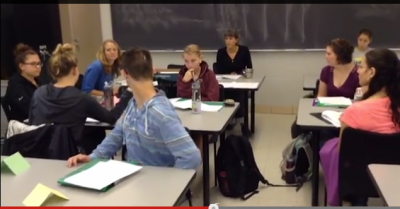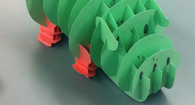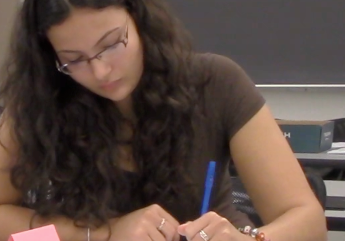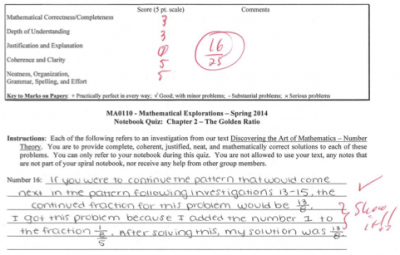Student learning and growth is at the heart of our project. Our students' transformation comes from growth in many areas: discovering powerful relationships between themselves, the world, society, patterns, rigorous thinking, and communication. To assess growth in all these diverse areas, we have been developing a rich toolkit for assessment. See the menu for links to blogs about specific assessment tools. This is joint work by Julian Fleron, Philip Hotchkiss, Volker Ecke and Christine von Renesse.
I thought that the teacher would just stand up at the board and write a bunch of stuff that I wouldn't understand and then we would have a big test on it and I would fail. To my surprise, it was nothing like that.
Choosing Weights for Assessment Techniques
Even in our small group of four, we make very different choices about the assessment components and their relative weights. For instance, Julian Fleron and Christine von Renesse use the following:
| Julian Fleron | Christine von Renesse |
| Complete solution sets (75%) | Class participation (40%) |
| Poster presentation (10%) | Projects (20%) |
| Class participation (10%) | Homework (20%) |
| Journal entries (5%) | Final exam (20%) |
Full details can be found in the following syllabi:
Other Grading Ideas...
Our Goals for Students' Learning
- Students will strengthen their reasoning skills and become better problem solvers.
- Students will strengthen their skills in reading, writing, argumentation and speaking.
- Students will become more self-monitoring, reflective learners and take greater personal responsibility for their learning.
- Students will approach mathematics more positively and gain a balanced perspective of mathematics.
- Students will understand the ubiquitous role of mathematics in the world around them.
- Students will improve their mathematical confidence.
- Students will appreciate mathematics as a human endeavor which is one of our most fundamental intellectual pursuits.
- Students will understand that mathematics is a vital, rapidly growing field of inquiry with a dedicated cohort of practitioners
- Students will understand the continued impact of mathematics in shaping history, culture, logic, philosophy, and knowledge, as well as its role as a humanistic and aesthetic discipline.
- Students will develop awareness of the negative impact of broadly-held societal views.
- Students will be capable of and interested in considering mathematics outside of the confines of the classroom, understanding the value of life-long learning in mathematics.





